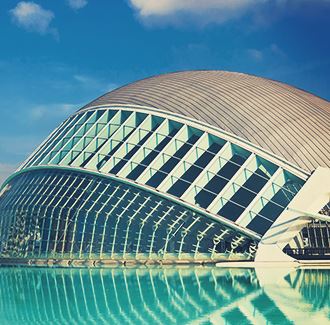Valencia: a feast for the senses
Peculiar traditions...
Founded by the Romans during the 2nd Century B.C., Valencia would eventually become the capital of a Moorish kingdom. It was incorporated into the Kingdom of Spain during the 15th Century, becoming a centre for commerce and culture. It is a city of peculiar traditions, many colours, distinctive sounds, smells and intense flavours.
The local language is Valencian, a variant of Catalonian. Every Thursday, at the Plaza de la Constitución, one can watch a session of the Tribunal de las Aguas: an ancient court of law formed by local farmers, active since the 10th Century. Valencia is also known as “the city of one hundred bells”, which are constantly playing in the many towers, buildings and old churches. The landmarks include the Valencia Cathedral (La Seo), a medieval building decorated with paintings by Goya, nearby El Miguelete Gothic tower (14th Century), Convento del Carmen (a convent built during the Middle Ages and the Renaissance) and the Baroque style of the Tower of Santa Catalina (18th Century).

If you are visiting in March, you can enjoy the Falles, a great Valencia popular festival with large parades of floats with paper statues and structures. In August, wear some old clothes and join the Tomatina: a “street battle” with thousands of people with fresh tomatoes as weapons - a lively event, indeed.
… and a renewed face
The rich historical heritage is just one side of the city, standing in an interesting contrast to the “new” Valencia.
The early 20th Century modernism can be seen in buildings such as Estació del Nord (a 1917 train station) and the gigantic Mercado Central (a market built in 1928), where you can do some shopping! The Jardínes del Túria also stand out: these gardens were built in 1957, after a flood that damaged the city. The event led to a re-routing of the Turia river - afterwards, a large area was left free for the installation of this green park that stretches out for 9 kilometres.


The cultural scene is not limited to the Ciudad: at the National Museum of Fine Arts of Valencia you can find Spain’s second biggest art collection; Valencian Institute of Modern Art (IVAM) is focused on contemporary art; and you can also enjoy music, theatre and dance performances at places like Palau de la Música, Teatre Principal or Teatro Rialto.
A dynamic life
Valencia invites people to go out on the streets, cycle and enjoy outdoor activities. Besides the historic centre, one must also discover the green areas — the aforementioned Jardínes del Túria include hiking trails, cycling tracks, orchards, cafés and terraces along the paths which follow the old course of the re-routed river. Nearby you can also find Bioparc, which includes a zoo dedicated to the African fauna and its connection with Mediterranean biodiversity.
Exploring such a diverse city will certainly make you hungry — which is not a problem in Valencia. The local cuisine is known for its richness and variety, and the city is surrounded by La Huerta, a very fertile farm region. When you sit on a restaurant, make sure you order a paella - after all, “Spain’s national dish”, with its base of rice and seafood, was created in Valencia! Restaurants and bars also serve the typical tapas and their countless and unexpected variants.
After a nice dinner, go forth in the Valencian night! You can catch a taxi or walk to Plaza de España and dance to the sound of Latin music. You can also have a drink in a bar at Zona Carmen. Or you can go to the Ruzafa area and watch an alternative rock concert. There is plenty of choice!


